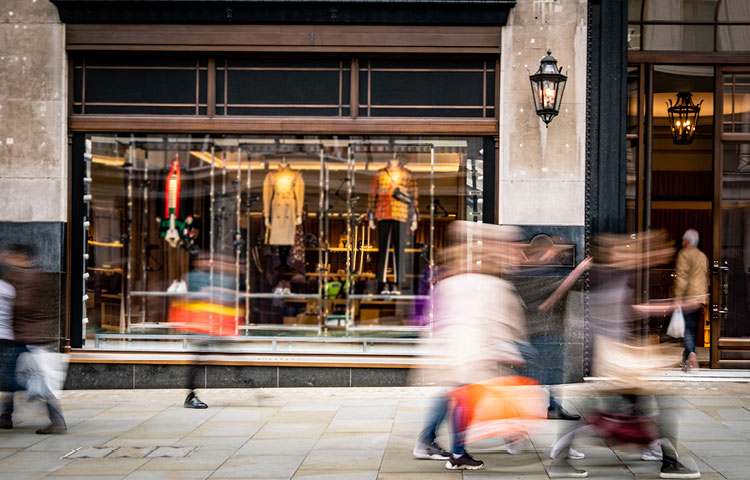From the abrupt shutdown of non-essential retail in 2020 to the challenges of surging operating costs, supply chain disruptions, labor shortages and evolving consumer preferences, the retail industry has embarked on a turbulent journey in recent years. However, the initial stepwise recovery from the pandemic eventually paved the way to a period of robust growth; in 2023, vacancy rates at shopping centers were the lowest they’ve been in decades. While not all retailers proved resilient enough to weather these trials, those who did are now well-positioned to anchor the retail CRE sector for years to come.


Retail Resilience: Retailers Put to the Test
James Bohnaker • 11/6/2023
Retail’s Hottest Trend: Physical Stores
The number of retail stores are rising after a four-year downturn that began in 2017 and continued to deepen during the pandemic. After nearly breaking even in 2021, net openings hit a nine-year high the following year, and momentum continued through 2023.
Driven by an influx of new discount retail locations from companies like Dollar General, Family Dollar and Dollar Tree, net openings through September 2023 are estimated at just under 1,100 stores. The three discount brands mentioned above account for 30% of gross store openings this year and will add over 16 million square feet (msf) of occupied retail space.
But the pipeline of store openings is not limited to discounters—retailers in the apparel, footwear, beauty and accessories segments are expanding for the first time in years. Brands that traditionally occupied inline mall space—Bath & Body Works, Skechers, Gap and Foot Locker, for example—are moving into open-air shopping centers near their target customers. Even department and big box stores, such as Macy’s, Nordstrom and Target are pivoting toward smaller format stores in suburban neighborhood shopping centers, further contributing to net store openings.
In addition, there has been a notable increase over the last decade in consumer services tenants, particularly in the education, healthcare, food services and fitness categories. This diversification strengthens shopping centers, making them more resilient to economic cycles and shifts in consumer spending, including e-commerce.
However, the demand pipeline is not without its blemishes. Home and office retailers have announced 1,500 closures this year, nearly 70% of which are Bed, Bath & Beyond and Tuesday Morning locations. Rite Aid’s recent bankruptcy filing could result in more than 150 store closures, on top of the nearly 500 combined closures from CVS and Walgreens.
Sizing Up Retailer Health
Aggressive expansion plans are easy to justify when retail sales are booming in an ultra-low-rate environment, but those days have passed. The story is now much more nuanced, as some brands will have the necessary capital and revenue growth to continue opening stores, while others are strategically shrinking store footprints in response to consumer trends and economic uncertainty. Retailer sales performance aptly reflects these dynamics, although there are over- and under-performers in each segment, making it difficult to paint a picture of tenant health with a broad brush.
The cost of opening retail stores has increased amid rising expenses for materials, labor and rent, in addition to financing challenges that have recently emerged. As of mid-October, the 10-year Treasury rate was near 5% for the first time since 2007, up from 3.5% in early 2023 and 1.75% before the pandemic. Larger, creditworthy brands with fixed-rate loans will not be immediately affected, but borrowers with outstanding debt at floating rates (typically smaller, private companies) and those who need to refinance or tap new lines of credit, face significantly higher costs compared with a year ago.
Higher debt burdens are a leading cause of bankruptcy, which is usually a precursor to widespread store closures. After hitting a peak in mid-2020, retail bankruptcies fell to historically low levels in 2021, but have begun to climb again in 2023. Through mid-October, retail bankruptcies have already surpassed 2021-2022 levels, with 25 declared thus far.1 Filings such as Bed Bath & Beyond, Party City, Rite Aid and Shoe City will result in an estimated closure of 683 stores and 8.75 msf of space on the market.2 The good news is that recent bankruptcies have had little impact on market fundamentals, as evidenced by the successful re-leasing of vacated space by these retailers.3
Banks have been scaling back exposure to riskier borrowers after the regional bank failures this year, and this is affecting some retailers. This is not an issue for the most financially sound borrowers, but a handful show signs of potential distress, which will make it more difficult to source capital in a risk-off environment. There are at least 11 retail and consumer service firms with risky credit ratings of “below satisfactory” or worse, all of which have been downgraded in the last six quarters.4 The FRISK© Stress Index for Retail Trade5 indicates a 60% increase in financial stress among publicly traded global retail firms in the last 18 months, consistent with 2008 and 2020 peaks. Retailers are cutting costs via layoffs and careful inventory management, and store opening plans could also be at risk of downgrades.
Small businesses and digitally native brands (DNBs) are also vulnerable, as they are typically viewed as risky borrowers in the eyes of lenders, potentially limiting crucial capital infusions needed to fund store openings. In the third quarter, small business owners were more pessimistic about credit conditions than at any time in the last decade.6 DNBs are twice as likely to be unprofitable compared with brick-and-mortar operators and report more severe challenges accessing capital.7 Fortunately, venture capital markets are still investing in retail concepts, albeit in a more selective manner than in recent years. Venture funding for DNBs is down 24% from 2020-2022 averages, yet it is still on par with the relatively vibrant pre-pandemic period—an encouraging signal that brands launching today will contribute to retail CRE demand over the next several years.
The sobering reality of the economic climate needs to be taken in context. Failure rates of speculative-grade debt are historically low industry-wide, and although expected default rates will rise over the next year, they are likely to settle at levels consistent with the 2017-2019 period, significantly lower than the fallout from the global financial crisis of 2007-2009.8 Additionally, retail companies have about 8% more cash on hand relative to current liabilities than they did in 20079, and this offers an important capital reserve to mitigate financial hardship. Risk is also highly concentrated rather than a symptom of industry-wide stress. Evercore ISI’s October watchlist of retailers at risk for store closures cited 30 public and private companies, down from nearly 90 before the pandemic.
Structural Themes Provide a Buffer
The next few years will be another test for the retail sector, but we are cautiously optimistic for several reasons:
- The retail sector is better prepared for an economic downturn, with a pipeline of healthy retailers ready to absorb oncoming vacant space as bankruptcies and closures continue to rise.
- Limited new retail construction means prime space will remain scarce, presenting opportunities for healthy retail brands to secure high-quality locations and strengthen market share, potentially with less competition.
- With e-commerce becoming highly saturated and logistics costs surging, physical retail offers a cost-effective avenue for sales growth, directing the focus of established retailers and emerging DNBs to brick-and-mortar stores.
- The increasingly diverse tenants occupying retail space are placing a greater emphasis on community needs, such as healthcare and fitness services, helping to insulate the sector from spending fluctuations.
In the face of what is anticipated to be another challenging year, the retail sector continues to demonstrate remarkable resilience. While tenant demand is expected to experience pockets of weakness, the overall health of the retail sector is favorable compared with past periods of uncertainty, supporting a balanced outlook for occupiers and landlords over the coming years.
1 S&P Global Market Intelligence
2 Cushman & Wakefield analysis of data from Coresight Research
3 https://www.cnbc.com/2023/04/28/bed-bath-beyond-store-closures-land-grab.html External Link
4 RetailStat Credit Database
5 FRISK Stress Index produced by CreditRiskMonitor assesses the collective probability of company failure over the next 12 months
6 NFIB Small Business Optimism Index
7 https://www.retaildive.com/news/retailers-grapple-e-commerce-profitability/625450/ External Link
8 https://www.yahoo.com/lifestyle/moody-predicts-rise-retail-debt-193746346.html External Link
9 U.S. Census Bureau Quarterly Financial Statistics
Subscribe to Retail Insights
Business Contacts
Related Insights

MarketBeat
Article

Research
Retail Resilience: Consumers at the Helm


